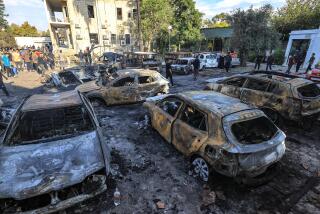But whoâs counting?
The difference between a million and a billion is a number so vast that it would seem nearly impossible to confuse the two.
Take pennies. At the website of the Mega Penny Project, you can see that a million pennies stack up to be about the size of a filing cabinet. A billion would be about the size of five school buses.
Or take real estate. A home in a nice part of Los Angeles might cost a million dollars. A billion dollars would buy the whole neighborhood.
FOR THE RECORD:
Numbers: A Jan. 31 opinion article, âBut Whoâs Counting?,â attributed the term âinnumeracyâ to Temple University professor J.A. Paulos. The term had been used by others before Paulosâ book, âInnumeracy,â popularized it. The article also used the middle initial E for financial swindler Bernard Madoff. His middle initial is L. â
But journalists canât seem to keep the two numbers straight. Committed as we are to getting the smallest details right, we seem hopelessly prone to writing âmillionâ when, in fact, we mean âbillion.â
I know this because Iâm an avid reader of our daily corrections -- as well as an occasional contributor. Reading about other peopleâs mistakes can be educational. Thatâs how I learned, for example, that itâs âdowitcher,â not âdowager,â if youâre talking about a bird, and that the large clam popular in Asian cooking is a geoduck, not a âgooey duck.â More important, each item there is a bright red flag about a mistake I easily could have made had not someone else beat me to it.
As The Times database editor and an informal coach on newsroom numeracy, I pride myself on not having made the million-billion mistake -- so far. But I find myself dismayed by the frequency of its appearance.
In a search of The Times database, my colleague Maloy Moore found 23 instances of this mistake in the last three years. By far the most commonly misstated unit was the dollar. Thus the losses for 1,600 investors suing Bernard E. Madoff were not $4.69 million as we reported, but $4.69 billion.
Budgets are an especially fertile medium for error. California, for example, spent $59.7 billion, not million, on education in 2008-09.
I did some calculations and found that The Timesâ mistakes totaled about $1.4 trillion, or about twice the amount the U.S. spent on the TARP bailout. Our brethren at the New York Times did even worse, making 38 million-billion mistakes in the same three years. Oddly, they were far more likely to overstate the case, doing so almost one time in four. The total of all their errors was $6.5 trillion, or more than half the amount of the national debt.
Itâs possible that the New York Times is more rigorous in correcting its errors, or that it runs a lot more stories about money. But I take pleasure in the fact that the L.A. Times isnât the nationâs standard-bearer for innumeracy.
Those who study and fight against innumeracy -- a term coined by John Allen Paulos in his book by that name -- concede that the million-billion confusion is aided and abetted by the similarity of the words. They just sound so disarmingly alike. But probably more significant than the pronunciation tripwire is the difficulty average people have visualizing large numbers.
âGenerally people do not have sufficient experience with large numbers to have any intuitive sense of their size,â said Lynn Arthur Steen, professor emeritus of mathematics at St. Olaf College. âThey have no âanchorâ to distinguish a million from a billion the way they might âfeelâ the difference between $10 and $10,000. So mistakes easily slip by unnoticed.â
No matter how well one can articulate a principle, one step from the familiar can make it extremely difficult to apply. In one story, we said 31 million plastic bottles can be produced from 17 million barrels of oil. We should have said 31 billion. It wouldnât have taken much math to figure that one out -- a half barrel of oil to make one bottle? But even some of the best reporters freeze at the prospect of a simple calculation.
More diligence would probably have prevented many of our million-billion slips, but after observing The Times newsroom for decades, I canât avoid the conclusion that our collective numeric literacy -- like that of most of America -- is appallingly low.
Iâve always thought that every aspiring reporter should be required to take a statistics course. If reporters were better versed in the subject, theyâd be less likely to assume, say, that a high mortality rate means a hospital is bad.
âThe hospital with the highest mortality rate in Los Angeles is probably the best one,â said Milo Schield, a professor of statistical literacy at Augsburg College in Minneapolis and director of the W.M. Keck Statistical Literacy Project. It is more likely to handle the sickest patients, and thus more likely to have patients die.
Schield, who is about to publish a research paper on statistical literacy for journalists, said journalists are failed by an educational system that doesnât distinguish well between math and quantitative literacy, and theyâre not alone.
âYou can be educated in calculus and be uneducated in quantitative literacy,â he said.
Newspapers should always break large numbers down into rates that make sense, he said. Rather than simply talking about Californiaâs $59-billion education budget, newspapers should break that out as $4,900 per household (ouch!), not the $4.90 it would be if the figure were in millions.
Schield has created a course called quantitative journalism. Heâd like to see it become standard in all journalism schools. âMost stories get more support by having numbers,â Schield said. âKnowing how to use those numbers is an art like any other.â
Iâm on board with that, though I think journalists share a particular trait that deadens their perception of scale. Media coverage responds to the perceived interest in the story as much as to its real importance.
Thus, a story about a single death or a scam involving a few peopleâs savings can command the same attention as a corporate meltdown or a natural disaster that kills thousands -- depending on how far away it occurs.
I think weâve done a good job characterizing the degree of suffering the recent earthquake caused the people of Haiti. But it will be a challenge explaining the cost of rebuilding the country.
More to Read
Inside the business of entertainment
The Wide Shot brings you news, analysis and insights on everything from streaming wars to production â and what it all means for the future.
You may occasionally receive promotional content from the Los Angeles Times.











